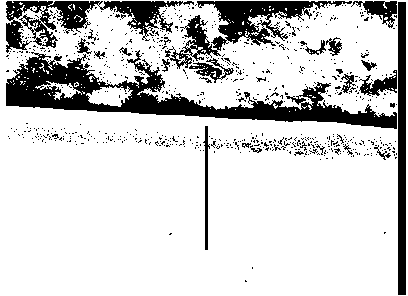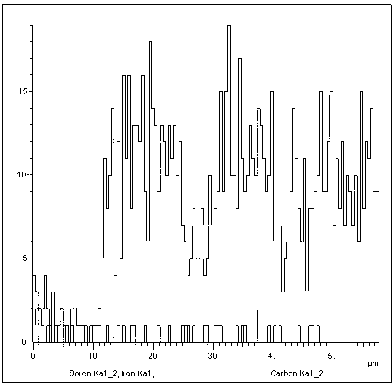Surface wear-resistant strengthening treatment method for high-carbon cold work die steel
A cold work die steel and strengthening treatment technology, applied in metal material coating process, coating, solid diffusion coating and other directions, can solve the problem of unstable quality of vanadium infiltration layer, and achieve good process energy saving and good bonding strength , the effect of a wide range of applications
- Summary
- Abstract
- Description
- Claims
- Application Information
AI Technical Summary
Problems solved by technology
Method used
Image
Examples
Embodiment 1
[0024] Embodiment 1: A method for surface wear-resisting strengthening treatment of high-carbon cold-working die steel, wherein the material of the high-carbon cold-working die steel is Cr12MoV, comprising the following steps:
[0025] (1) Preparation of salt bath mixture: first add borax to a stainless steel crucible, heat the salt bath at 950°C for 4 hours, then add BCl 2 , NaCl and KCl, stir evenly, after 15min, add V 2 o 5 and metal yttrium, stir evenly, after 20 minutes, add aluminum, stir evenly, after 20 minutes, raise the temperature to 1060 ℃, keep warm for 3 hours;
[0026] (2) Salt bath: put high-carbon cold-work die steel at room temperature, co-infiltrate for 6 hours, and keep the temperature at 1060 °C to obtain a vanadium-carbon-boron wear-resistant layer on the surface;
[0027] (3) Quenching and tempering: Quenching directly, and then tempering at 220oC for 10 hours.
[0028] The element content mass percent of the salt bath mixture is: 80% borax, 3% BCl ...
Embodiment 2
[0030] Embodiment 2: With reference to Embodiment 1, the material of high carbon cold working die steel is T12A, including the following steps:
[0031] (1) Preparation of salt bath mixture: first add borax to a stainless steel crucible, heat the salt bath at 960°C for 4 hours, and then add BCl 2 , NaCl and KCl, stir evenly, after 16min, add V 2 o 5 and metal yttrium, stir evenly, after 18 minutes, add aluminum, stir evenly, after 20 minutes, heat up to 1050 ℃, keep warm for 4 hours;
[0032] (2) Salt bath co-infiltration: put high-carbon cold-work die steel at room temperature, co-infiltrate for 6 hours, and keep the temperature at 1050 ℃ to obtain a vanadium-carbon-boron wear-resistant layer on the surface;
[0033] (3) Quenching and tempering: Quenching directly, and then tempering at 200oC for 10 hours.
[0034] The element content mass percent of the salt bath mixture is: 82% borax, 3.5% BCl 2 , 0.5% NaCl, 2.5% KCl, 6% V 2 o 5 , 1.5% metal yttrium, 4% aluminum.
...
Embodiment 3
[0036] Embodiment 3: With reference to Embodiment 1, the material of high carbon cold work die steel is GCr15, comprising the following steps:
[0037] (1) Preparation of salt bath mixture: first add borax to a stainless steel crucible, heat the salt bath to 945°C for 4 hours, then add BCl 2 , NaCl and KCl, stir evenly, after 18min, add V 2 o 5 and metal yttrium, stir evenly, after 20min, add aluminum, stir evenly, after 20min, heat up to 1060 ℃, keep warm for 3.5 hours;
[0038] (2) Salt bath co-infiltration: put high-carbon cold-work die steel at room temperature, co-infiltrate for 6 hours, and keep the temperature at 1060 ℃ to obtain a vanadium-carbon-boron wear-resistant layer on the surface;
[0039] (3) Quenching and tempering: Quenching directly, and then tempering at 210oC for 10 hours.
[0040] The element content mass percent of the salt bath mixture is: 81% borax, 3% BCl 2 , 1% NaCl, 2% KCl, 6.5% V 2 o 5 , 1.5% metal yttrium, 5% aluminum.
[0041] The vana...
PUM
| Property | Measurement | Unit |
|---|---|---|
| thickness | aaaaa | aaaaa |
| thickness | aaaaa | aaaaa |
| thickness | aaaaa | aaaaa |
Abstract
Description
Claims
Application Information
 Login to View More
Login to View More - R&D
- Intellectual Property
- Life Sciences
- Materials
- Tech Scout
- Unparalleled Data Quality
- Higher Quality Content
- 60% Fewer Hallucinations
Browse by: Latest US Patents, China's latest patents, Technical Efficacy Thesaurus, Application Domain, Technology Topic, Popular Technical Reports.
© 2025 PatSnap. All rights reserved.Legal|Privacy policy|Modern Slavery Act Transparency Statement|Sitemap|About US| Contact US: help@patsnap.com


